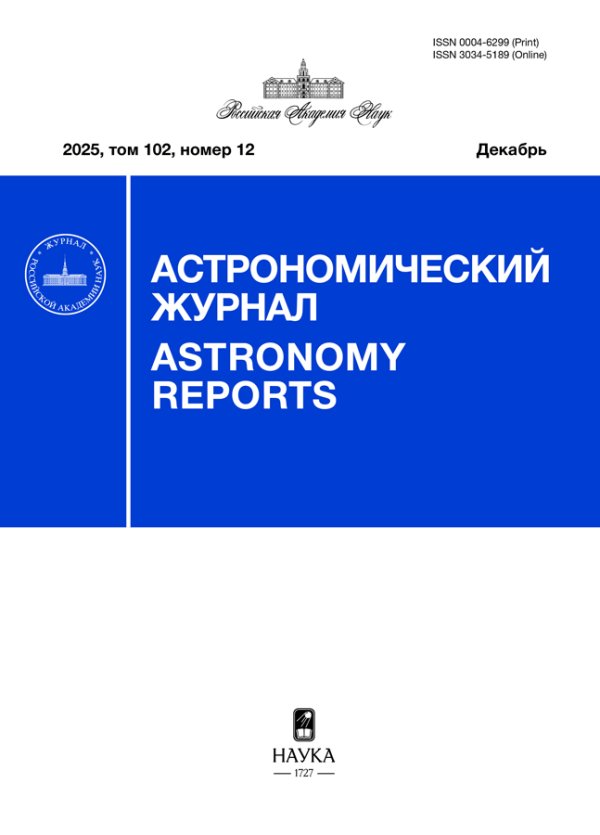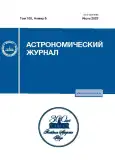Vol 100, No 6 (2023)
Articles
Investigation of the Effect of the Errors of Limb Darkening Coefficients on the Geometric Parameters of a Binary System with an Exoplanet
Abstract
Based on the observed light curves of Kepler-5, Kepler-6, Kepler-7, HD 209458, a search was made for the geometric parameters of a binary system with an exoplanet for different values of the limb darkening coefficients of the parent star. It is shown that for the observed light curves with relative accuracy 10−4−10−5, an error by a factor of several times in the value of the limb darkening coefficient does not significantly affect the values of the planet radius, stellar radius, and orbital inclination.
 481-487
481-487


Orbital Period Variations of the Eclipsing Binaries RX Ari and V449 Oph
Abstract
The variations in the orbital period of the eclipsing binaries RX Ari and V449 Oph have been analyzed. It has been shown that the variations in the period of RX Ari can be represented by a superposition of a secular period increase and two cyclic variations. The secular increase in the period can be explained by the exchange of matter between the components. Cyclic variations in the period may be due to the presence of two additional bodies in the system, or only one additional body in combination with the magnetic activity of the main component. The variations in the orbital period of V449 Oph can be represented with almost equal accuracy either as a superposition of two cyclic variations, or as a superposition of a secular period increase and two cyclic variations. The obtained parameters of the light-time effects and magnetic quantities lead to the conclusion that it is preferable to use linear elements to represent the variations in the orbital period of V449 Oph. In this case, one of the cyclic variations can be a consequence of the light-time effect, and the second one can be a consequence of the magnetic activity of the secondary component. Both types of variations can also be a consequence of the magnetic activity of the secondary component.
 488-499
488-499


Mass Computations of the Brightness of Stars in an Arbitrary Spectral Band
Abstract
The problem of calculating the brightness of an array of stars in an arbitrary photometric band, which is not the standard band of astronomical photometry, is considered from their multicolor photometry in some other photometric system. A similar problem is to transfer photometric measurements of stars from one multicolor photometric system to another. This task includes methods for calculating and comparing magnitudes, as well as merging photometric catalogs. The questions of choice of various zero-points of photometry and reduction of measurements for the atmosphere are considered. The issues of reducing the error of the proposed methods are discussed. The article is partly based on a report presented at the conference “Modern Stellar Astronomy-2022”, held at the Caucasian Mountain Observatory of the Sternberg State Astronomical Institute, Moscow State University, in November 8–10, 2022.
 500-511
500-511


The Catalog of Resolved Spectroscopic Binaries: Development and Description
Abstract
Resolved spectroscopic binaries are unique among other types of binaries. They provide the only possibility (aside from trigonometric parallaxes) to accurately determine distances to objects, which is one of the most important characteristics in astronomy. Such binaries are not numerous, but an exhaustive catalog of them still does not exist. The authors have developed a pilot version of a new catalog of resolved spectroscopic binaries. It contains information about orbital elements, component masses, parallaxes, and other parameters for 107 stars. Thus, the catalog represents the most extensive list of resolved spectroscopic binaries known to date. A preliminary analysis of the distributions of the stellar parameters of the objects in the catalog has been carried out, as well as a comparison of the trigonometric parallaxes from Gaia DR3 with the orbital parallaxes. The article is partly based on a report presented at the conference “Modern Stellar Astronomy-2022,” which was held at the Caucasian Mountain Observatory of the Astronomical institute of Lomonosov Moscow State University on November 8–10, 2022.
 512-516
512-516


Detection of Two New RRATs at 111 MHz
Abstract
At the LPA LPI radio telescope, a search was conducted for pulse signals in a specific area with declinations +52°<δ<+55°. The processing involved ten months of observations recorded in six frequency channels, each with a channel width of 415 kHz and a total bandwidth of 2.5 MHz. The analysis of the data revealed 22 000 events, exhibiting a pronounced dispersion delay of signals over the frequency channels, which are indicative of pulsar pulses. These pulses were found to belong to four known pulsars and two new rotating radio transients (RRAT). Additional pulse search was carried out in 32-channel data with a channel width of 78 kHz. This led to the discovery of 8 pulses for the transient J0249+52 and 7 pulses for the transient J0744+55. No periodic emission of transients was detected. The analysis of the observations indicates a high probability that the identified RRATs are pulsars with nullings, where the fraction of nullings is greater than 99.9%.
 517-523
517-523


Method of Circular Gaussian Rings in Perturbation Theory
Abstract
An extended approach to the model of circular Gaussian rings is developed to study the secular evolution of the orbits of two planets under the influence of mutual gravitational perturbation. The orbits of the planets have a small mutual inclination angle and are represented by circular rings, on which the masses, semimajor axes and inclination angles of the orbits, as well as the orbital angular momenta of the planets are transferred. The role of the perturbation function in the problem is played by the mutual gravitational energy of the rings, which is obtained in integral form and as a series in powers of slope angles. The coefficients of the series are expressed in terms of elliptic integrals. The method for the first time considers the discrepancy between the nodes of the planets’ orbits and has been developed in two versions: (i) with a large and (ii) small angles between the nodes of the orbits. For each of these options, systems of 4 differential equations describing the secular evolution of orbits are compiled and solved in the final analytical form. It is proved that the angle of mutual inclination of the orbits remains constant in the process of evolution in both cases. Option (i) is tested on the example of the Sun–Jupiter–Saturn; option (ii) is tested on the evolution of orbits of exoplanets Kepler-10b and Kepler-10c. For both systems, the precession parameters were calculated and the diagrams were plotted.
 524-534
524-534


Analysis of the Possibilities of Short-Term Prediction of Geomagnetic Perturbations from Observations of Coronal Mass Ejections at the BSA LPI Radio Telescope
Abstract
From April 2021 to October 2022, in the monitoring data obtained daily at the Big Scanning Antenna radio telescope (BSA LPI), 11 events were identified for which X-ray flares in the solar corona were followed by magnetic storms on Earth. Interplanetary scintillation monitoring data were considered together with data on solar flare activity and a simple kinematic model of ejection propagation. Based on the estimated ejection velocity between the Sun and the probed region, under the assumption of a constant velocity, the time of arrival of the ejection to the Earth was calculated. Of the 11 events considered, 7 are associated with solitary flares followed by a coronal mass ejection (CME) and 4 are more complex and possibly associated with corotating perturbations or a superposition of corotating and flare perturbations. For the entire set of events, the average time of the real onset of a magnetic storm after the time predicted by the model was 3.6 h and the average time between the onset of scintillation enhancement and the onset of a magnetic storm was 20.1 h. For events associated with solitary flares, the magnetic storm began, on average, 0.8 hours after the predicted time and 15.6 hours after the onset of scintillation enhancement. The delay of magnetic storms with respect to the predicted time is apparently related to the deceleration of the ejection between the probed region of the solar wind and the Earth’s orbit.
 535-545
535-545


Corotating Disturbances of the Solar Wind in the Monitoring Data of Interplanetary Scintillations: Simulation and Observation
Abstract
A simple model has been proposed for the leading part of an interaction region between solar wind streams of different speeds. The model describes an increased plasma concentration as a spiral jet with a rectangular cross-section. Using this model, two-dimensional dynamic maps of interplanetary scintillation level distribution were calculated, which were specifically adapted to the configuration of the BSA LPI radio telescope. The model calculations were compared with the data from a series of observations of interplanetary scintillation during four geomagnetic storms in 2022 and 2023, caused by corotating disturbances. The calculations and observational data exhibit a qualitative correspondence. It has been shown that corotating disturbances manifest as scintillation enhancement three days before a geomagnetic storm, occurring at around 15:00–16:00 Moscow time. Over the next two days, the scintillation enhancement zone shifts to a later time, while there is no enhancement in the morning sector. During the actual geomagnetic storm period, there is an increase in night scintillations. This sequence of scintillation enhancement indicates that the disturbance approaches Earth from the eastern side while rotating with the Sun. The qualitative differences between the observational data for corotating and propagating large-scale disturbances are discussed.
 546-556
546-556


Neural Networks for Searching for Meteoral Signals in the Data of the Orbital Telescope “UV Atmosphere”
Abstract
Since 2019, the Russian–Italian experiment “UV Atmosphere” (Mini-EUSO) has been operational on the International Space Station. The primary instrument of this experiment is a wide-angle telescope positioned toward nadir. Its main objective is to generate an ultraviolet map of the Earth’s nocturnal atmosphere radiation. This map serves as a crucial element in the preparation of a large-scale experiment involving the study of extremely high-energy cosmic rays using an orbiting telescope. Similar to the preceding TUS experiment, the “UV Atmosphere” instrument detects signals from various atmospheric processes in the ultraviolet range, including the luminosity of meteors. In this paper, we describe two simple neural networks that effectively extract meteor signals from the overall data stream. The proposed approach can also be applied to identify track-like signals of various origins in the data obtained from fluorescent and Cherenkov telescopes.
 557-566
557-566












